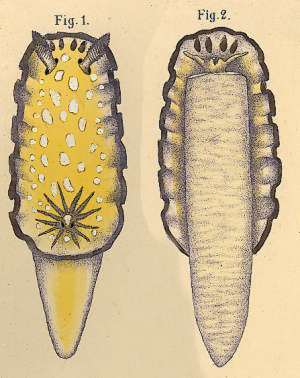Original illustration of Doris propinquata Pease 1860
March 7, 2005
From: Bill Rudman

Here is another message concerning the white and purple-spotted chromodorids described from Hawaii by Pease and Garrett. In this one I post the original illustration of Doris propinquata, Pease, 1860
Doris propinquata was originally described (Pease, 1860) without an illustration. Bergh (1881: Pl. G, fig 1-2) subsequently published a painting by Andrew Garrett, which we assume was available to Pease. He called it Chromodoris propinquata.
Here is Pease's description of the external colour:
Colour above bright yellow, becoming white at the margins, which are bordered irregularly with purple; four oblong dots of the same colour in front of the dorsal tentacles. Dorsal tenatcles purple on the outer portion. Branchial plumes edged with the same colour. Length 1 inch 3 lines. This Doris possesses the same habit of vibrating its branchial plumes as Doris vibrata.
Kay & Young (1969) suggest this is probably C. vibrata, because they both vibrate their gills, but it could also be Risbecia imperialis which does the same. The large posterior foot is much more like a species of Risbecia than a Chromodoris.
-
Pease, W.H. (1860) Descriptions of new species of mollusca from the Sandwich Islands. Proceedings of the Zoological Society of London 28: 18-36.
-
Bergh, L.S.R. (1881) Malacologische Untersuchungen. In: C.G. Semper, Reisen im Archipel der Philippinen, Wissenschaftliche Resultate. Band 2, Supplement 2., 79-128, Pls.G, H, J-L.
Bill Rudman
Rudman, W.B., 2005 (Mar 7) Original illustration of Doris propinquata Pease 1860. [Message in] Sea Slug Forum. Australian Museum, Sydney. Available from http://www.seaslugforum.net/find/13253Related messages
-
Re: Risbecia imperialis from Hawaii
From: Cory Pittman, January 9, 2007 -
Risbecia imperialis from Hawaii
From: Aidan Hampson, January 5, 2007 -
Original illustration of Doris prismatica var imperialis Pease 1860
From: Bill Rudman, March 7, 2005 -
Trailing in Risbecia imperialis
From: Scott Johnson, August 17, 1999
